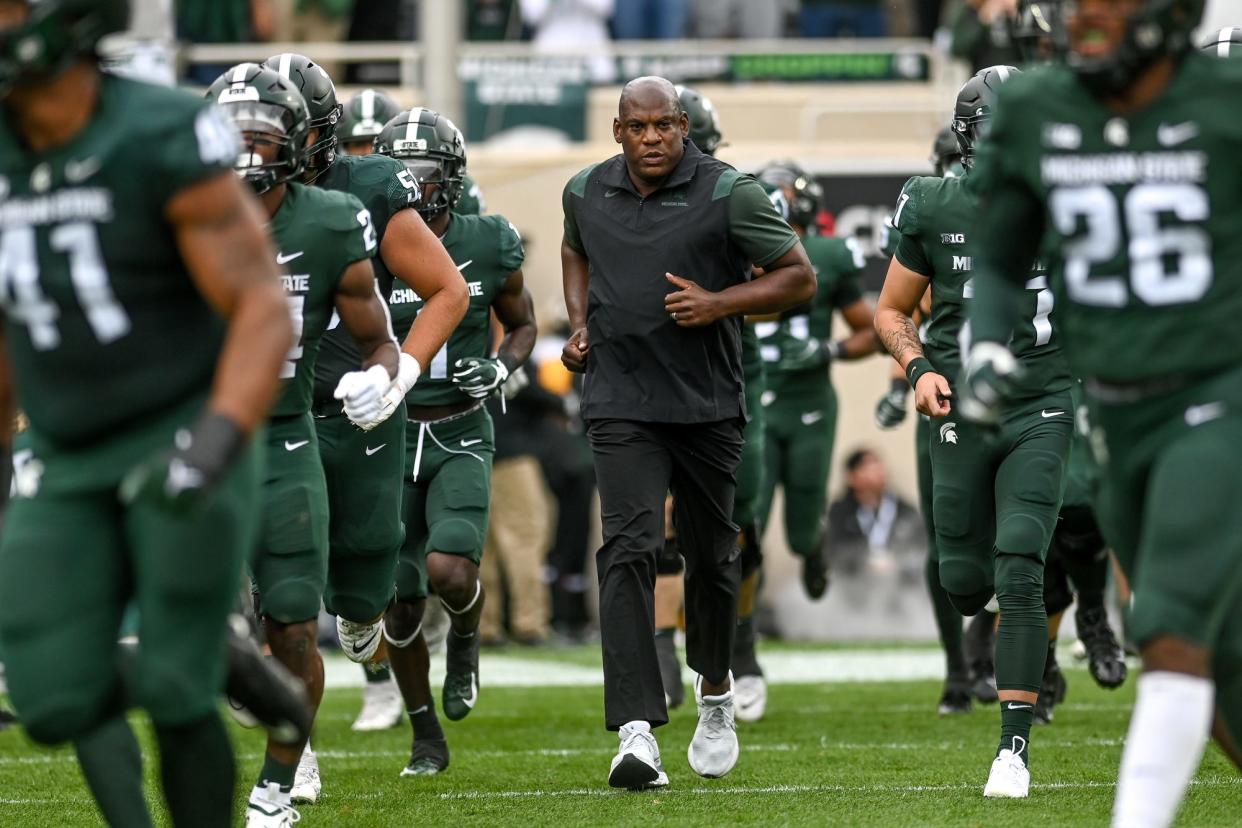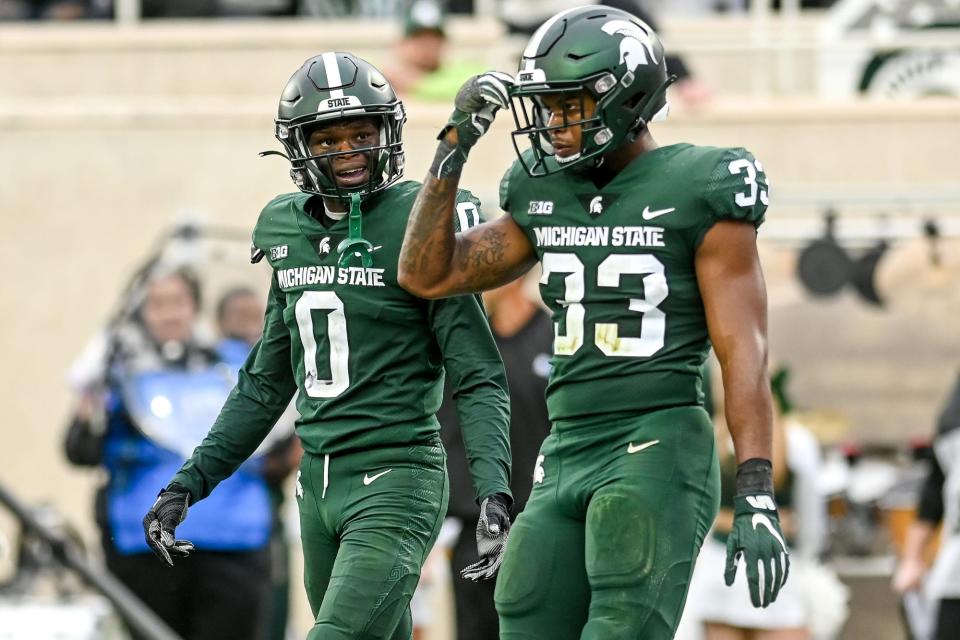Couch: How MSU football got here, when it might improve, and when it's fair to expect Mel Tucker's program to thrive

- Oops!Something went wrong.Please try again later.
- Oops!Something went wrong.Please try again later.
EAST LANSING – Everything you might be feeling about Michigan State’s football program right now is Kenneth Walker’s fault. Really. He did this.
He created a sense that MSU’s rebuild had zoomed past several painful stages. He made Mel Tucker part genius, part genie — seemingly playing chess in the transfer portal, capable of granting every wish Spartan fans have ever had.
Walker made MSU’s offensive line good enough. He gave the Spartans’ defense swagger. He helped a dangerous receiving duo become overwhelming at times. He gave a young quarterback cover and room to grow. He gave Tucker catchphrases that became culture. When it’s all working, it’s easier to keep choppin’. When you’re winning, hell yeah, this is deep water. Tuck Comin’.
Walker created a buzz that outlived his time in East Lansing.
We just didn’t know the depth of his influence until Washington and Minnesota tore through the void.
Without Walker this season, with an offensive line that’s a little less and two running backs who aren’t quite him, the running game has stalled badly, which has crippled the offense entirely. So MSU’s defense, which can’t get off the field, is always on the field. Last year, the Spartans gave up a whole heap of yards, but then rested while Walker and Co. did their thing offensively — putting together drives, scoring points, putting the other team on its heels. The defense fed off of that. They just had to come up with timely sacks and takeaways and stiffen in the red zone. They could do that. And did. For a while, at least. It became part of their persona. MSU’s defensive players had swagger, even when they had no reason for it.
It was all Walker.
One player does not make a program. But, for a year, Walker sure as heck elevated MSU’s.
There should be no regrets about last season. That 11-2 run was a welcomed distraction alongside the work at hand. And it might, in time, prove to have hastened MSU’s rebuild when we look back and dissect its impact on recruiting and culture-building.
What we’re witnessing now, though, is like part of the film “It’s a Wonderful Life” — as if Walker had never been born.
So how did the Spartans get here, in this place where they’re struggling to even compete with programs that shouldn’t ever be beyond their realm? When will it look different? And, separately, how long until it’s fair to say Tucker and Co. have had time to build a program that meets your dreams?
I’ve seen and heard people this week talk about Year 3 being a particularly tough year in many program rebuilds. Because that’s when the previous regime’s final — and often weakest — recruiting classes are the crux of the roster. That might have been true for Mark Dantonio in 2009, his Year 3, and I’ve seen it elsewhere. But this situation is different, worse in some ways.
This isn’t really Year 3 for Tucker. Because of when Dantonio retired and the pandemic that hit soon after, Tucker’s first actual recruiting class — not done on Zoom — is MSU’s true freshman class right now. He’s a couple classes behind where he might have been if he’d instead been hired in early December of 2019 and also not had the COVID interruption before he could get started.
The trouble with that is it makes Year 4, next season, just as challenging. That’s usually the year it’s fair to truly begin to judge a college football coach. But in Tucker’s case, in terms of whether he can elevate MSU to consistently contend for championships, that evaluation should be in Year 6, when his first class recruited with on-campus visits is seniors and redshirt juniors.
Yet it also can’t look like it has the last two weeks until 2025. The program shouldn’t be getting rocked by Washington and Minnesota — no matter how good those two teams turn out to be this season. It might be not fair to expect Tucker’s Spartans to compete yet with Ohio State, but the Gophers and Huskies and, this week, the Terrapins? MSU’s roster should never be outclassed in those matchups.
Let’s be clear about what we saw against Minnesota. MSU did not score when it mattered or force a punt the entire game against the Gophers. At home in Spartan Stadium. In response to a rough outing a week earlier. Last Saturday’s game is up there with the great fiascos in Spartan football history. MSU's coaches have to find a way to get this team to play with confidence.
Tucker and defensive coordinator Scottie Hazelton this week both sounded like men with answers, but not answers for this team. There’s a lot of talk about “death by inches.” But that’s also a hard way to win. The Spartans don’t have the dudes right now to make it not always about the inches.
MORE: Inside the players-only defensive meeting after Michigan State's loss to Minnesota

MSU is beginning to feel the pain of its 2020 recruiting class (though the 2019 class wound up being a fairly strong group). There will be holes on this roster for at least two more seasons, even if Tucker and Co. continue to deftly use the portal to fill them. MSU is also perhaps feeling the pain of losing some of Dantonio’s guys, rather than developing them.
Would the Spartans be better in the defensive backfield right now with some mix of Julian Barnett (who’s at Memphis), Chris Jackson (Washington State), Davion Williams (Western Kentucky), Kalon Gervin (Kansas) and safety Michael Dowell (Miami-Ohio)? There is something to be said for developing and growing within a program. All of those players have left since Tucker took over and made it clear: “Compete to play, compete to stay.”
Dantonio kept everyone when he took over — like, actually everyone — and won nine games in his second season. Those were different times, pre-transfer portal. And that first Dantonio Big Ten championship squad in 2010 was largely made up of his own guys anyway, after his fourth recruiting class had arrived on campus. Again, if you’re judging in those terms, for Tucker, that’s 2025 or, at the earliest, 2024.
Because what else has become clear: Having a bevy of notable transfers (MSU started three on offense and five on defense last Saturday) can’t make up for years of sound recruiting and development, with one notable exception, of course.
Also not helping: Dantonio’s final class, in 2020, really wasn’t a Dantonio-esque class. It was devoid of defensive backs — his specialty — with safety-turned-linebacker Darius Snow and corner-turned-safety Angelo Grose as the only additions to the secondary. If Dantonio and Co. had identified one more diamond in the rough on their way out — a Darqueze Dennard- or Josiah Scott-type — that would have been a tremendous help.
Dantonio didn’t leave a pass-rusher of note, either. The Spartans haven’t had one since Kenny Willekes, a former walk-on, and haven’t recruited a scholarship edge rush rusher who’s wreaked havoc since Shilique Calhoun. Tucker inherited Jacob Panasiuk, a productive defensive end as a senior last season, but he’s gone now. This August, a week before the opener, MSU’s staff moved UNLV transfer Jacoby Windmon to defensive end and, for two weeks, against two MAC opponents, it worked. Maybe it will again. Florida transfer Khris Bogle has shown some promise there early, though he’s now among a throng of defensive players battling injuries. That’s a part of this story, too. MSU’s defense is playing without — or at times has been without — senior safety Xavier Henderson, Snow, All-Big Ten defensive tackle Jacob Slade, defensive tackle Simeon Barrow and defensive end Jeff Pietrowski.
That’s a lot to lose in four weeks for a program still in transition, yet to see the fruits of more heralded recent recruiting classes.
MSU’s offensive line is equally a problem right now. I firmly believe the Spartans have the goods to be an effective — and even explosive — offense at every other position. I thought they’d be OK up front, too. Good enough, like last year, even if not as deep. That hasn’t been the case.
Perhaps when younger linemen like redshirt-freshman Ethan Boyd (2021 class) and 2022-ers Gavin Broscious, Ashton Lepo, Braden Miller and Kristian Phillips are more seasoned, the Spartans will be ready to roll. The offensive line is a tough position group for a quick fix.
“I think we’re going to go as far as the offensive line takes us,” Henderson said before the season.
Hence the last two weeks.
I’ve written before that MSU’s football program under Tucker is in this weird place, on two parallel tracks — one being the 11-2 season, the expectations that year created for the here and now, and the other track being the program’s actual trajectory as Tucker and his staff incrementally build the program through recruiting. The first of those tracks has taken a hit. There’s no sign yet, however, that there’s been any damage to the other. None of the 10 four-star commits in the Spartans’ 2023 class have publicly wavered. And the day after MSU was walloped by the Gophers, Tucker and Co. picked up a four-star defensive back pledge for 2024.
We’ll see how solid all of that remains if this season continues to go south. For that reason, and others, this is a massive game at Maryland, perhaps the tipping point between 6-6 and 3-9.
MORE: Couch: Michigan State's performance against Minnesota isn't acceptable – at any price
Keeping folks believing in the big picture, in that second track, will require this staff showing they can stem the bleeding now. That's the job. They've got to be able to do it. It’ll take developing less-coveted recruits who didn’t pose with Lamborghinis on their recruiting visits, but instead saw a closed campus virtually.
At their peak, that’s what Dantonio and Co. did so well. It’s not all about how you look getting off the bus. I’d take Denicos Allen over anyone on MSU’s defense right now. I’d probably take Josiah Scott over any 6-foot-3 corner in the Big Ten.
To get where MSU and its fans want to go, Tucker has said it’ll take three or four difference-makers on each side of the ball, guys who make the margins a little less tight. Guys who can close on a receiver who a quarterback thinks is open. Guys whose footsteps can wreck a QBs confidence. Guys who barely need a crease to break a 15-yard run. Allen would count as that. Scott, too. Same for Walker. Definitely Walker. Great players. Not just good ones.
How many does MSU have right now? Any?
Like MSU's program, fans' patience and understanding should be on two parallel tracks. But the floor should be higher than last week.
Contact Graham Couch at gcouch@LSJ.com. Follow him on Twitter @Graham_Couch.
This article originally appeared on Lansing State Journal: How Michigan State football got here and when it's fair to expect more from Mel Tucker

